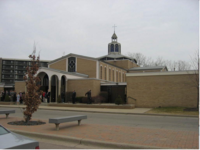Церковь Сурб Саргис (Детройт, Мичиган, США)
| Церковь Сурб Саргис (Детройт, Мичиган, США) | |
| Surb Sargis Hay Areqelakan Yekeghetsi (Detroit, Michigan, AMN) | |
| Армянская Апостолькая Церковь Св. Саркиса | |
| St. Sarkis Armenian Apostolic Church (Detroit, MI, USA) | |

| |
| Руководитель: | Rev. Father Daron Stepanian |
| Конфессии: | Армянская апостольская церковь |
| Состояние: | Действующая церковь |
| Адрес: | 19300 Ford Road, Dearborn, MI 48128 |
| Телефон/Факс: | (313) 336-6200, (734) 458-2644 Fax: (313) 336-4530 |
| Эл. почта: | hayrig@yahoo.com |
| Ссылки: | http://www.saintsarkis.org/ |
Michigan
19300 Ford Road, Dearborn, MI 48128
Pastor: Rev. Father Daron Stepanian, Tel: (734) 458-2644
Детройт`St. Sarkis Armenian Apostolic Church was established on May 24, 1942 on Waterman Street in Detroit, MI, in the name of the Saint Sarkis. The current location in Dearborn, MI was Dedicated on October 14, 1962 and since then it bestows spiritual and national needs of the Armenians in Eastern Michigan, and is one of the Churches of the Prelacy of the Armenian Apostolic Church of America under jurisdiction of the Holy See of Cilicia.
THE HISTORY OF ST. SARKIS CHURCH
According to historical records and old-timers, the history of Armenians in Detroit is between 100 and 105 years old.
They attest to the fact that the first Armenian to establish residence in the city was a Marzvantsi girl named Esther Nvart, who came here with a missionary to study medicine. Upon receiving an M.D. degree, she began the practice of medicine, married a local resident, and settled in Detroit. This is the scanty information gathered about the first Armenian in Detroit.
The older generations attest that about 1906 the Armenians in Detroit numbered approximately 45, only two of whom were married. One was a Marzvantsi named Krikor Chemberian. Among these first-comers was Der Garabedian, a pharmacist, Krikor Goshgagarian, who was able to speak English, and Mesrob Kurkjian, a real estate agent.
Witnesses also mention a priest, name unknown, who came from Providence, Rhode Island. He lived here for a while and talked about acquiring a church for the Armenians. He gathered everybody in the home of Khoungianos Keteyian and convinced them that the Armenians could not survive without an Armenian Church. He even appointed a Board of Trustees -- Khoungianos Keteyian, Toros Tavitian, Kaloust Sogoian, Khachig Der Manuelian, and others. They were unable to fulfill their mission, so the priest returned to Providence.
By 1915, the ranks of the Armenian Community had swelled to 3000 members. Detroit was a thriving industrial city, and when Henry Ford announced his $5.00-a-day wage policy, there was an influx of Armenians from all parts of the United States. They came with the sole intention of making money quickly and returning to their native land. Within a short time, Detroit became one of the largest Armenian Communities with an enthusiastic and dynamic Armenian life.
The Armenian Community in Detroit was a model community. It comprised of Armenians from Turkey, Iran, the Caucasus, and Russia. The Turkish Armenians outnumbered the others. There were Yozghatzis, Gessaratzis, Everegtzis, Fenecetzis, Gurentzis, Sepasdatzis, Shabin Karah- isartzis, Kharpertzis, Kghetzis, Yerzenghatzis, Darontzis, Vasbouragantzis, and Govgastzis, etc. Although Armenians migrated to the United States with the sole purpose of making money and returning to their homeland, destiny decreed otherwise. The repeated Turkish massacres, especially that of April 24, 1915, destroyed all hopes of returning to their homeland and they were forced to remain in the United States. Consequently, the Armenians began establishing a permanent community in a new land.
Up to the end of World War II, the Armenians of Detroit were congregated in the areas of Delray, Highland Park, Clark Park, and Allen Park. Shortly thereafter, they began to disperse to the suburbs. As a result, the Armenian Community of Detroit was no longer considered close-knit.
The community, numbering approximately 25,000, conquered the problems and difficulties that usually confront all immigrants. It progressively improved and prospered growing into a forward-looking and aggressive community, economically stable.
Almost all the Armenian families are homeowners. Many of them also own private enterprises. Furthermore, many Armenians have reached high positions in all fields of endeavor. The community has many doctors, lawyers, architects, scientists, pharmacists, professors, school principals, and teachers. There are also industrialists and lawmakers.
In conjunction with economic stability and progress, the Armenian community's national life prospered and moved forward. The Community established two Apostolic Churches, St. Sarkis and St. John, which adequately served congregations almost equal in number.
The Armenian Catholics and Protestants also established churches in Detroit.
In the early sixties, the community supporting the St. Sarkis Church had three Armenian schools -- Aghpalian School at the Armenian Community Center, Levon Shant School at the Armenian Civic Center, and the Oshagan School in the Allen Park region. These schools were administered and maintained by the Mid-Council of the Armenian Relief Society of Detroit. A total of 150 children attend those schools, and were taught ably by Mrs. Shooshanig Papakhian and Miss Marv Manoogian.
Wayne State University of Detroit had established courses in Armenian language. These courses were started in 1950 by the initiative of Professor Kevork Nakhnikian, who was supported, morally and financially, by the Mid-Council of the Armenian Relief Society, A.G.B.U., the Armenian Student Society, and St. John Cultural Association.
The countless problems, the deprivations, and the time and effort expended in the organization of this community with its many facets are incalculable. In time of need, be it local or national, be it moral or financial, the Armenian Community of Detroit was and is second to none.
The Detroit Community also built the Michigan Home for the Armenian Aged and the St. Sarkis Towers.




